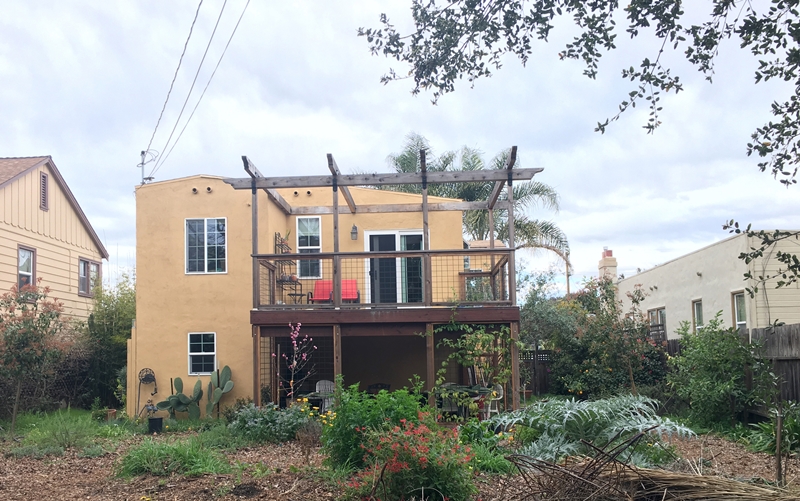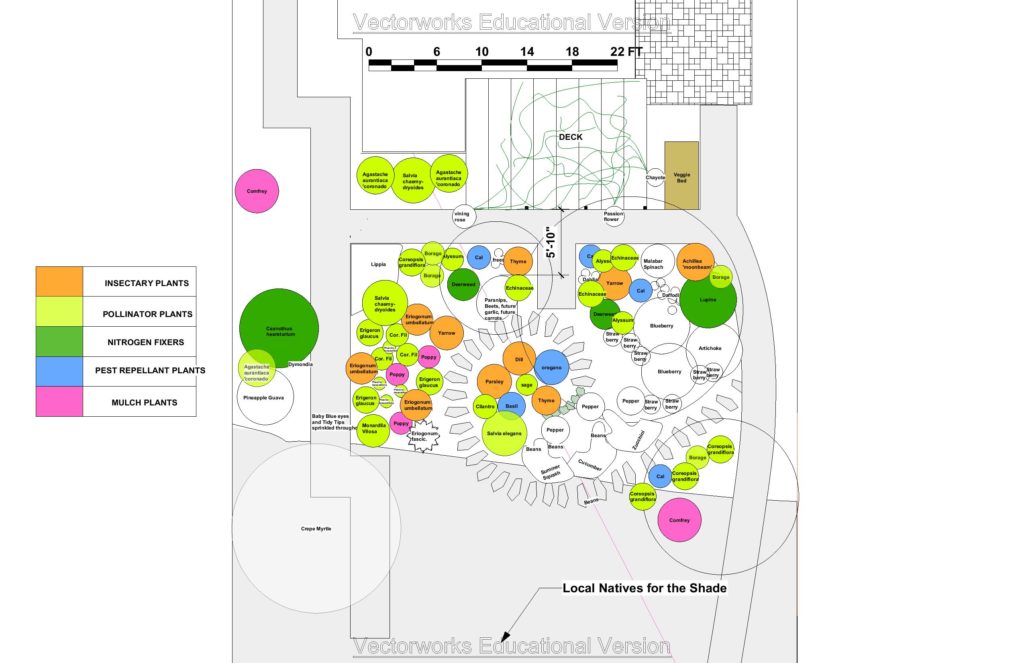Morningside Botanical Bounty

Food Forest Keeper: Diane
I’m an adjunct professor at USF and a book designer. I lived in San Francisco for almost 40 years until 2014. I lost my apartment of 30 years when my landlady died and the place was sold. The process of getting here was a nightmare, but it allowed me to fulfill one of my strongest, most longstanding dreams: homeownership.
With homeownership, came a large yard — a yard with two beautiful giant old oaks in the backyard and two and a half palm trees in the front with a little jungle between them. Everything else was a wasteland of Bermuda grass and weeds, shaved into the semblance of turf, complete with a sprinkler system. It was hot, dry, and gaunt in the summer and fall. The sun beat down on the house without mercy. It was massively weedy in rainy season, with a giant pool of water in the middle of the backyard.
Several years ago I participated in the Solano County program for replacing turf and sprinkler systems with low-water planting and permeable paths and a patio. This helped me to deal with the front and side yards. But, the state of the backyard was still awful and I had spent much of my time, money and energy dealing with first the inside of the house, dealing with the front and side yard gardens, and adding a deck for outdoor access from the main part of the house. I would wake up in the wee hours worrying about how I was going to deal with the unmanageable backyard.
Then came the miracle … Sustainable Solano’s Resilient Neighborhoods Program.
Permaculture, better watering systems, plant combining, supporting native bees, butterflies and birds, growing food and herbs, and more have interested me for decades. I’ve even used laundry detergent since the 1980s that could be used for a greywater system.
My neighbor, Carla, had met and connected with Sustainable Solano’s Kassie Munro at the Flyway Festival, sponsored by the Mare Island Preserve. They spent some time talking about the new Resilient Neighborhoods Program that was just being initiated. I was driving down my street a couple days after the festival and I saw Carla. I was so excited to see a neighbor out and about, I stopped to chat. She asked if I might be interested in the Resilient Neighborhood. I told her I was very interested. We connected with several of the other neighbors and joined in the process of creating our application, much like writing for a grant. I enjoyed this process of describing where my garden had come from and where I wanted to go with it. I’m very into things green and have been for a long time.
Learn more about the Morningside Botanical Bounty Resilient Neighborhood here
Site Details
Installation Date:
June 2019
Size:
1,454 square feet
Sun Exposure:
8 hours
Soil:
Clay
Number of Swales:
1
Secondary Water:
Laundry-to-Landscape Greywater System
Rainwater
Roof water diverted to swales
Total annual water impact:
28,682 gallons
Design:

Designer: Lauren Bennett
Plant List:
Crepe Myrtle, Fig, Peach Frost, Sweet Bay
Blueberry( Jubilee, Sharpblue), California Buckwheat, Coyote Mint, Deerweed, Germander Sage, Hearst’s Ceanothus, Pineapple Guava, Pineapple Sage
Artichoke, Baby Blue Eyes, Basil, Calendula, Cilantro, Comfrey, Common Lippia, Common Tidy Tips, Dahlia, Dill,
Hummingbird Hyssop, Large-flowered Tickseed, Lupine, Malabar Spinach, Parsley, Purple Coneflower, Seaside Fleabane, Sulphur Buckwheat, Sweet Alyssum, Thyme, Yarrow
Silver Carpet, Strawberry
Beet, Parsnips
Chayote, Malabar Spinach, Passionflower
Installation:
We requested things we wanted to see happen, plants we wanted to have, existing features of the yard — in other words, a very comprehensive design. I worked with [Designer Lauren Bennett] on the overall garden design. She was very knowledgeable and when it turned out that some things needed to be shifted in the design, she was flexible about it, changed things up quickly, and we came up with a very pleasing and functional design.
My garden was last to be dealt with, so on the Saturdays the month before I worked on my neighbors’ gardens. We laid down many sheets of cardboard, hauled many wheelbarrows of mulch and compost from giant curbside piles into the various yards, did trenching for the swales, hugelkultur mounds, drip irrigation and greywater systems. I really enjoyed connecting with my neighbors, Carla, Jane, Joanna and Chris, and Dominic and Jessica.
When my turn rolled around I was really grateful to see such a large group of volunteers show up. I could not have physically dug all those trenches or have afforded to pay someone to do it. Everyone was very generous with their time and energy. In addition to my wonderful neighbors, Jessica’s parents came out to help, family members of a church working on a project to help homeless female veterans came, some longstanding volunteers from Sustainable Solano, Sustainable Solano members and some of their smart and strong sons, newbies who were interested in installing greywater and drip irrigation systems, etc. The work was tough, the people were lovely, and the days went by quickly. And on the planting day, we were mostly done by lunch.
I’m incredibly happy with the renewed garden.
- A visually beautiful garden with a permaculture design was created that gets more lush every day. It is designed in a way that I’m continuing to learn from it.
- The plant combinations of food, herbs and trees is visually lovely as well as functional. Plant combining is something I want to know more about.
- Food, herbs and flowers to harvest. I’ve harvested lots of peppers, squash, chard and parsley. Unfortunately the blueberry bushes didn’t survive.
- The greywater system is growing the privacy and shade bamboo very rapidly. It’s amazing to look out and see that it is taller every time we do the laundry. We now refer to doing the wash as ‘watering the bamboo.’
- All the plants on the greywater line are doing very well, including the tree dahlias I’d planted last year, that had died back last fall.
- The drip irrigation is working well too. Some of the plants on it would be difficult to keep adequately watered without it. The new trees are doing well on their deep-watering regimen, including two of the trees from Arbor Day, that were in delicate shape.
- When I opened my windows in the evening after the install, I could smell the redwood mulch and the alyssum.
I really enjoyed meeting and working with everyone from Sustainable Solano, the volunteers, and getting to know my neighbors better. I feel the people involved were extraodinarily giving and so varied and interesting.
The neighbors on our block, even those not in the program, have been brought together. We’re now working as a group on getting our street narrowed, speed bumped or blocked to calm down traffic and adding shade trees. My thanks to everyone for this amazing experience, I feel it’s a new beginning for this whole neighborhood.
Vision for the Future:
My garden wish list:
- Extend the drip irrigation along the east side of the yard, without harming the bougainvillea and other lower-water plants.
- My neighbor to the east is removing both of his mature trees, so I would very much like to add one or two more smallish fruit trees, or tall, somewhat narrow trees on the east side of the yard. I’d like to replace the lime tree there, it has never fruited.
- Continue to wall off the rental house to the west, where the gardening service dumps glyphosate all over the yard and the neighbors use toxic dryer sheets many hours of the day. Seems like these may be common urban problems to examine.
- Extend areas of lipia groundcover — it chokes out the Bermuda grass better than any other plant here.
- Adjustment of the drip irrigation near the cactus path. The cactus is getting too much water.
- A wall of plants along the back fence about 12 feet high at maturity that like shade and won’t harm the existing old oaks. This is another toxic dryer sheet issue.
- Some way of managing and containing my giant compost heap, and maybe surrounding it with a living fence.
Morningside Botanical Bounty’s demonstration food forest was funded by the Solano County Water Agency as a part of Solano Sustainable Backyards. It was part of the first Resilient Neighborhood hub in Vallejo, with other work in that hub funded through Pacific Gas & Electric Corporation Foundation.

